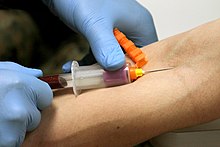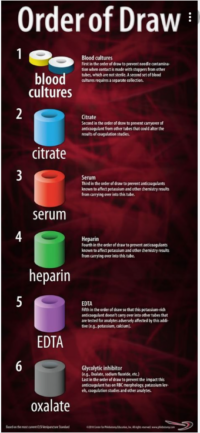The Order of Draw: A Look At Different Test Tubes
The venipuncture procedure is complex and requires trained, skilled labor to perform the necessary specimen collection. When performing a collection/draw, phlebotomists must have the proper equipment including needles, gauze, and the correct tubes for the required draw.
Phlebotomy collections require vacutainer tubes in order to draw blood from a patient’s vein. These are made from either sterile glass or plastic with a rubber stopper that creates a vacuum seal inside the tube. Once punctured by a needle, the blood is drawn into the specific tube. Depending on the tube type, different tubes may contain additives to stabilize and preserve the specimen for the required testing. Each tube has a different color rubber stopper that corresponds with the additive it contains.
Draw Process
To facilitate the blood draw, the vacutainer needle must be inserted into a patient’s vein. This is a double-ended needle; the inner end is encased in a thin rubber coating to prevent blood from leaking out while tubes are changed during a multi-draw process and the outer end is inserted into the vein.

Once the needle is inserted into the patient’s vein, often in the arm, a tube is then inserted into the holder. The rubber tube cap is punctured by the needle within the holder and the vacuum effect pulls blood through the needle and into the tube. For a multi-tube draw, once a tube is filled, a new one replaces it. These tubes must be drawn in a specific order to avoid cross-contamination of additives between them.
Order of Draw
The order in which a draw is performed depends on the number of tubes required. In the event that the draw requires multiple tubes, the order is a critical part of the phlebotomy collection process. As mentioned, different tubes contain different additives, and when these additives carry over into a different tube type, test results may be adversely affected. Since over 70 percent of all medical decisions are based on lab results, an accurate collection is a pivotal first step.
Phlebotomists, and skilled labor trained in phlebotomy, arrange the tubes in a specific order referred to as the “order of draw.” When followed, any additive carryover that may occur will not have a significant impact on the test results.
The recommended order of draw is as follows:
- Blood Culture Tubes – These collections are first to prevent needle contamination when contact is made with stoppers from other tubes, which are not sterile. These specimens are used to detect the presence of bacteria or fungi in the blood and to guide treatment.
- Sodium Citrate (e.g., blue-top/stopper) – The trisodium citrate additive in these tubes prevents blood coagulation (an anticoagulant). These are drawn second to prevent carryover of this additive that could alter the results of coagulation studies.
- Serum (e.g., red-, gold-, speckled-top/stopper) – The serum is collected for selected tests as ind
 icated. Tube inversions ensure the mixing of the clot activator with blood.
icated. Tube inversions ensure the mixing of the clot activator with blood.
- Red-Top: If plastic, these tubes contain a clot activator. If glass, there is no additive. Blood clots and the serum are separated using a centrifuge.
- Gold-Top: These tubes contain a clot activator and gel for serum separation; commonly referred to as a serum separator tube (SST). Upon centrifugation, the blood cells and serum will separate. This tube has a smaller volume of 5.0 mL.
- Speckled-Top: Contains a clot activator and gel for serum separation. Also an SST, but with a volume of 10.0 mL.
- Heparin (e.g., green-stopper) – Heparin is an anticoagulant used to prepare samples for biochemical testing. These tubes are used to produce plasma and may contain a gel to separate it. If the gel is present, the tube is considered a plasma-separating tube (PST). Tube inversions ensure the mixing of heparin blood to prevent clotting.
- EDTA (e.g., lavender-stopper) – EDTA, or ethylenediaminetetraacetic acid, is an anticoagulant used for most hematology procedures (i.e., identifying and counting blood cells, etc.). Tube inversions ensure the mixing of EDTA with the blood to prevent clotting.
- Oxalate (e.g., gray-stopper) – These tubes contain potassium oxalate as an anticoagulant and sodium fluoride as a preservative and are used to preserve glucose in whole blood, as well as certain chemistry tests.
MOMS Lab/Client Draws
The Labs/Clients on the MOMS platform have unique testing and use a combination of the above tube types in their test kits. Each lab/client provides specific draw instructions for the skilled labor at the MAP: Medical Access Point™ to perform a successful collection in order to receive a viable specimen for testing.
**Medically reviewed by Dr. Sona Kirpekar, MD
Before you go…
